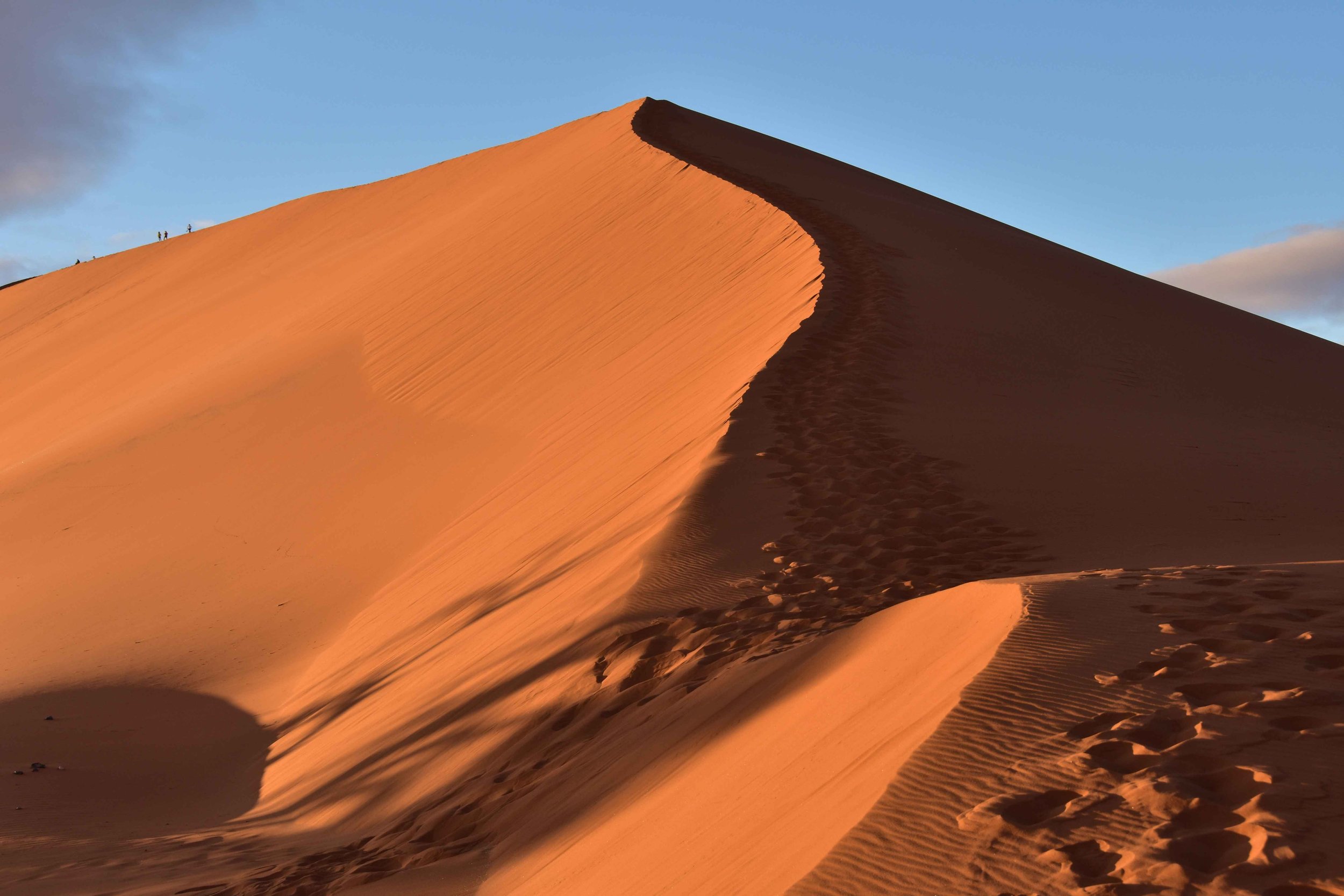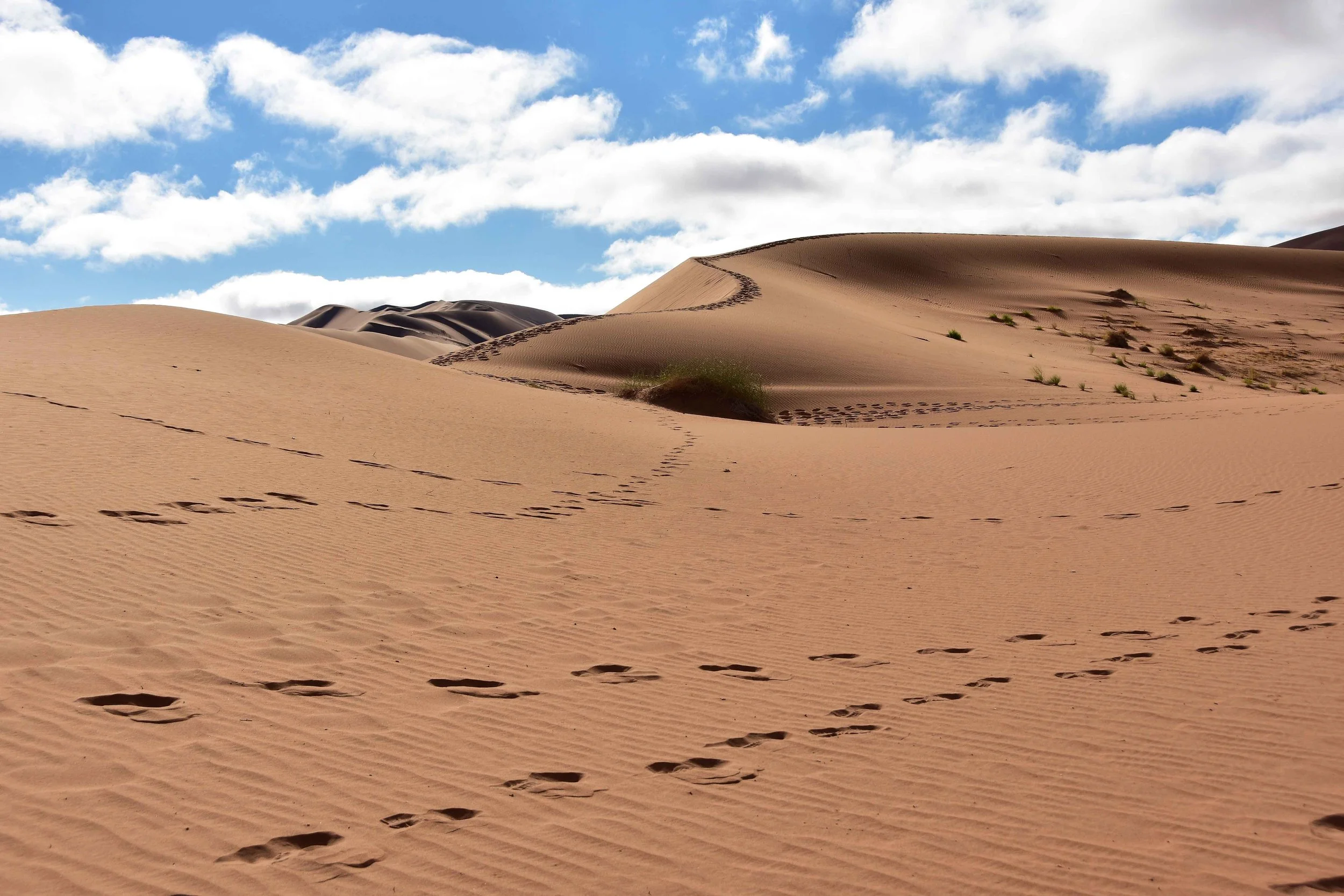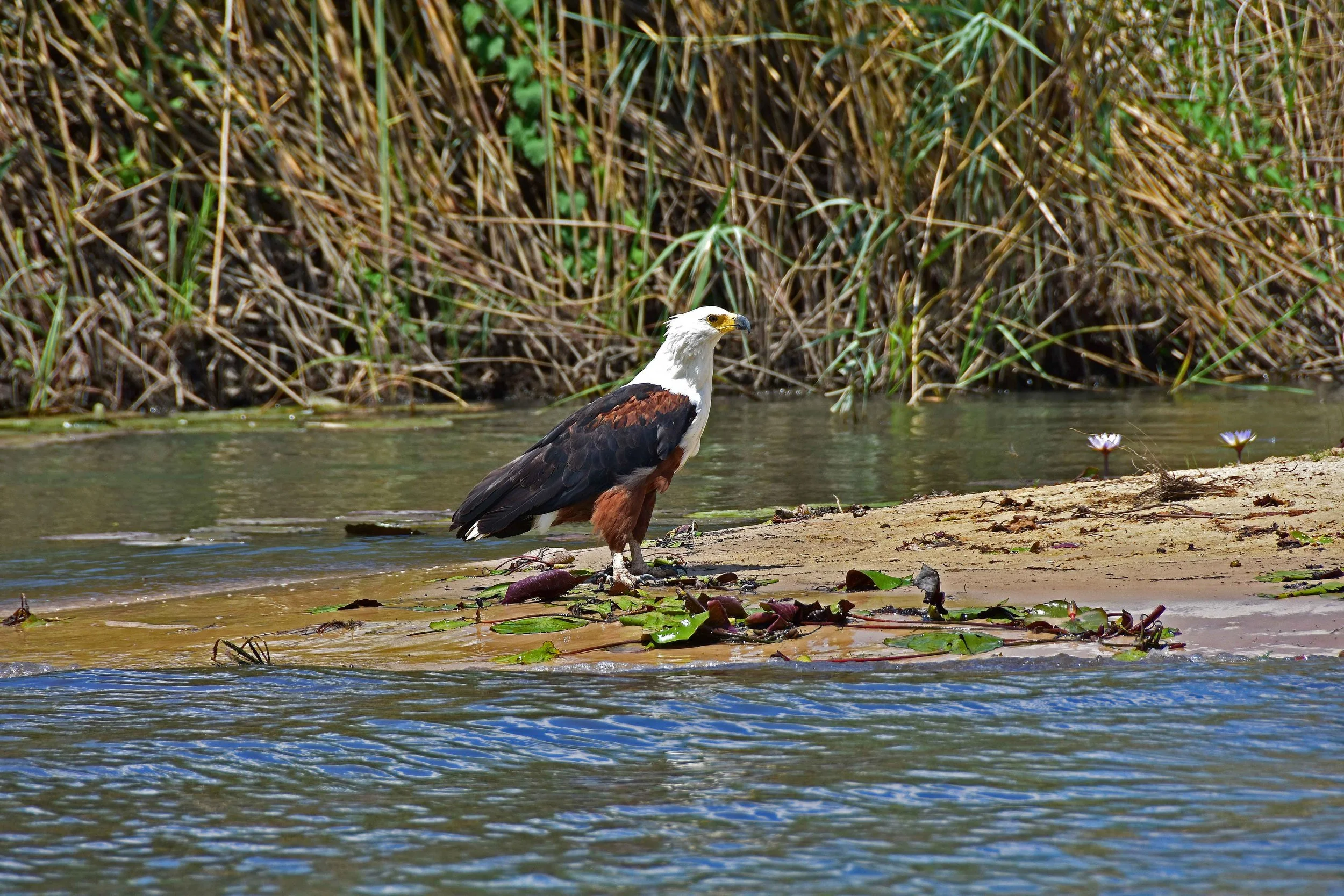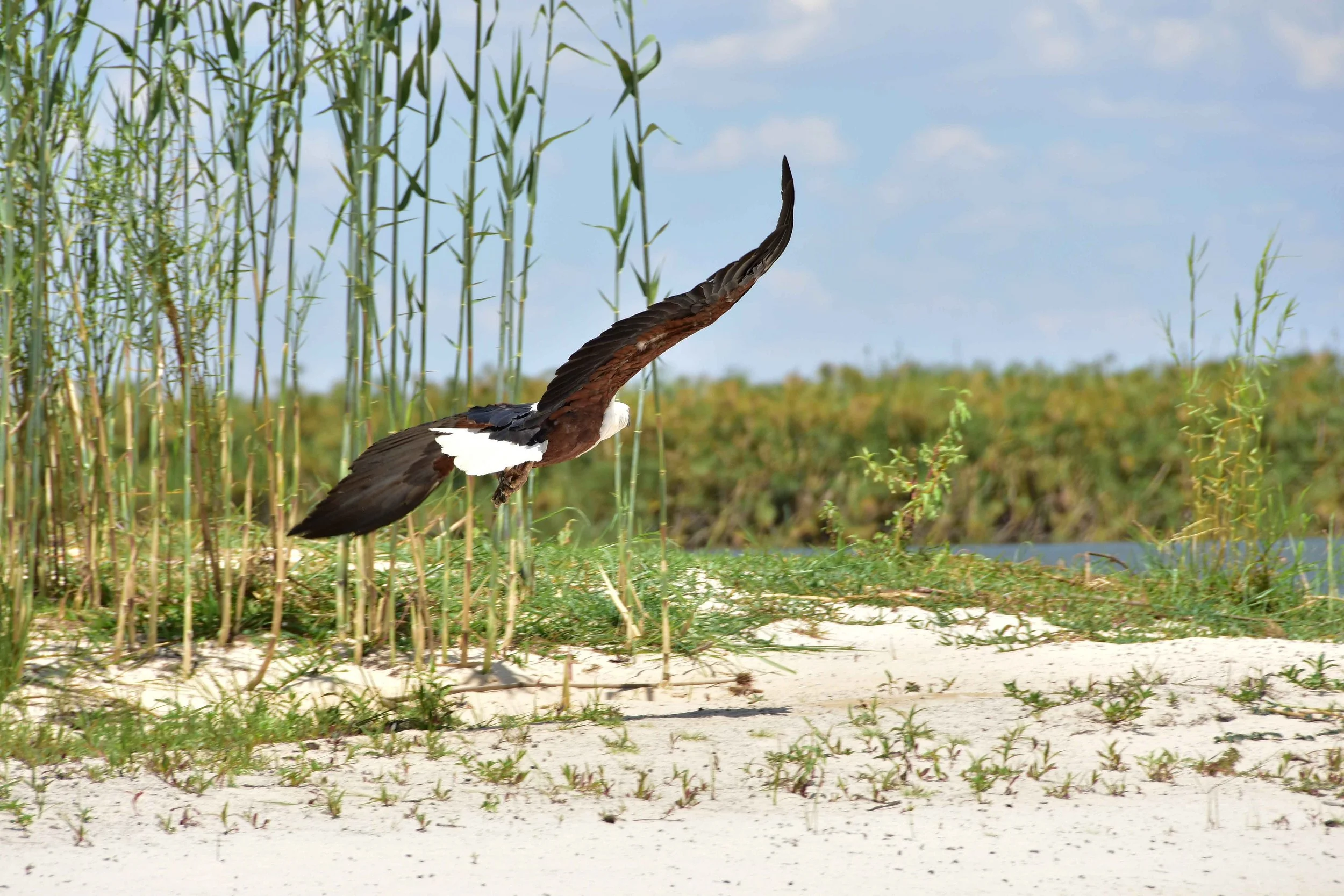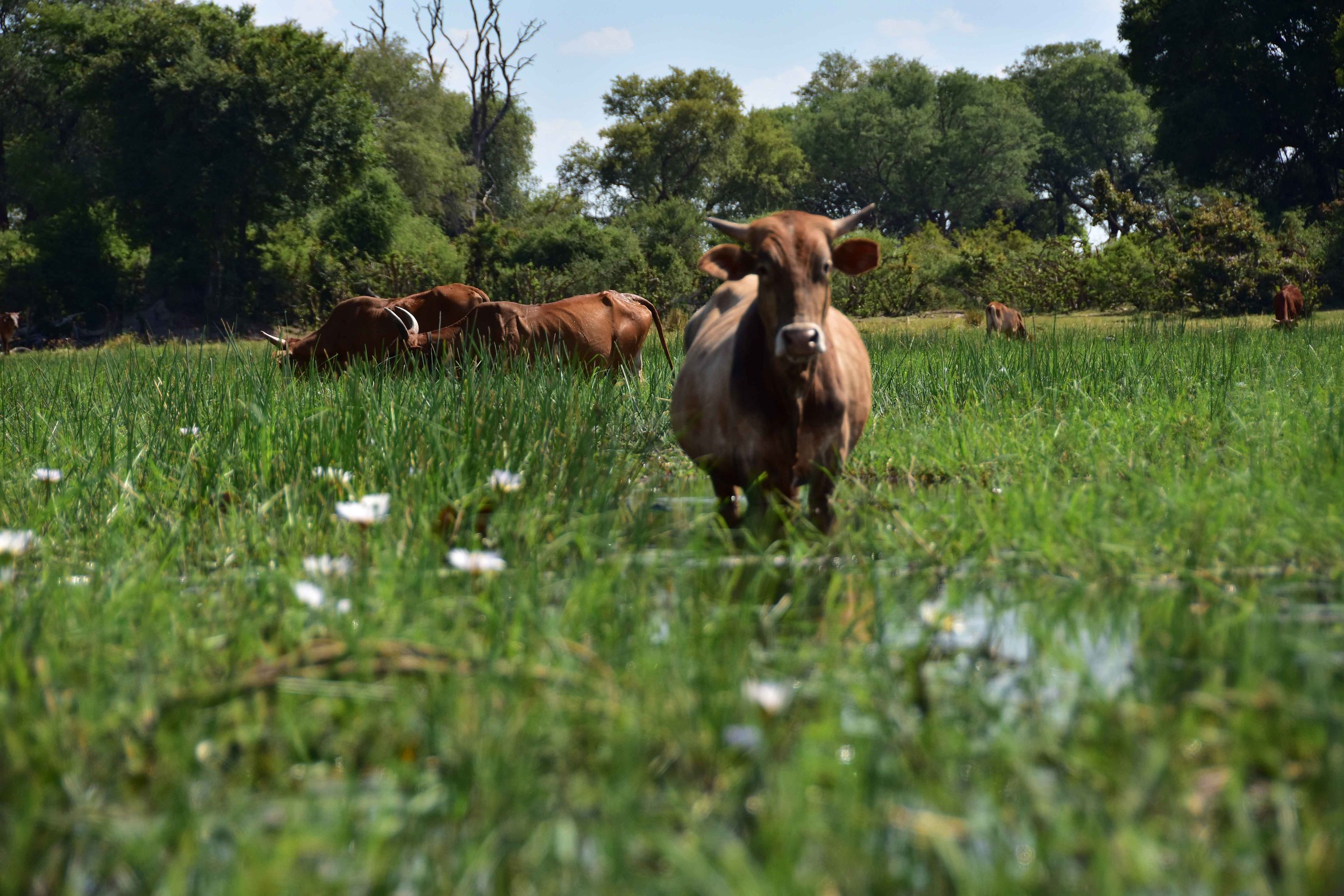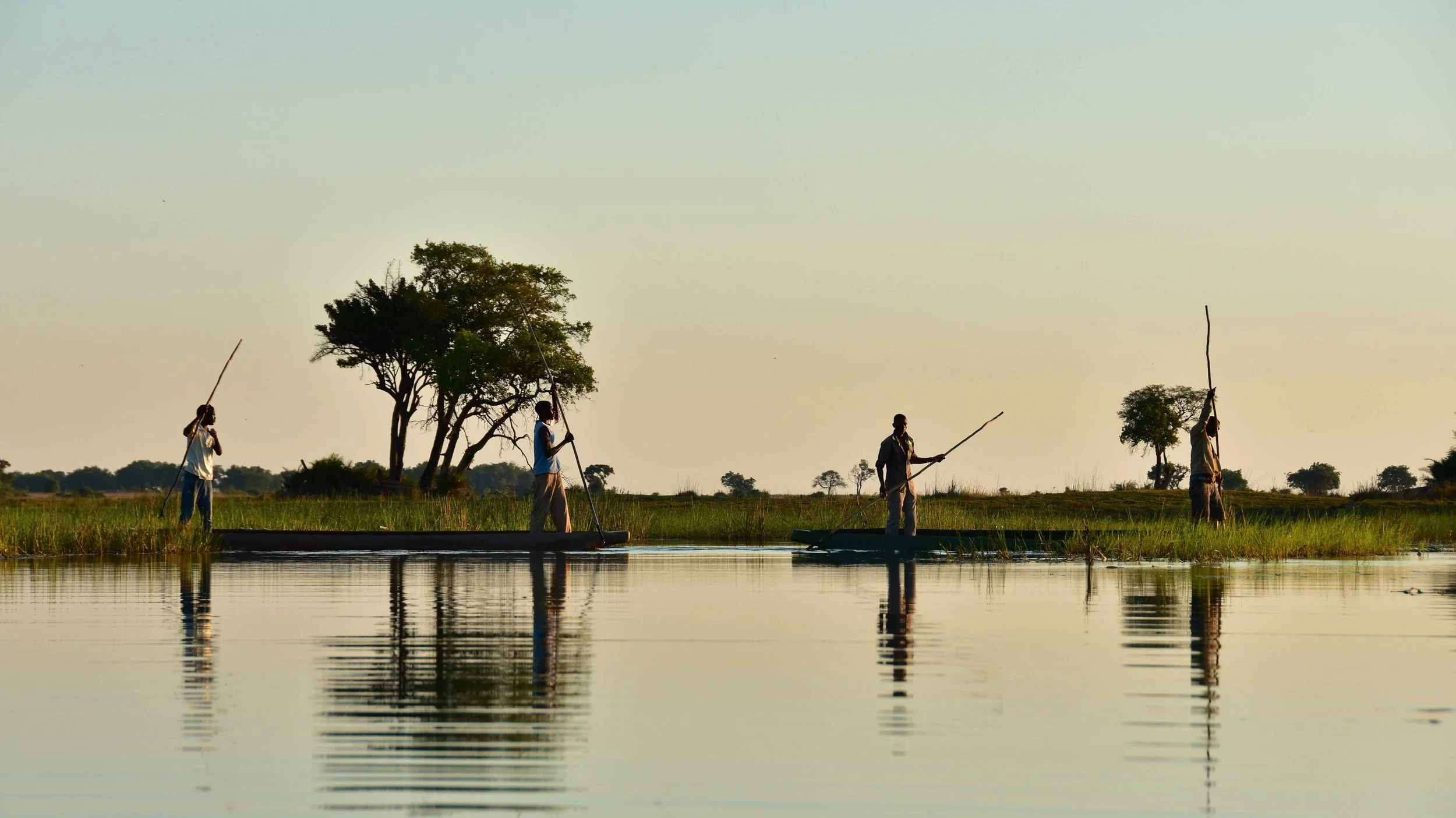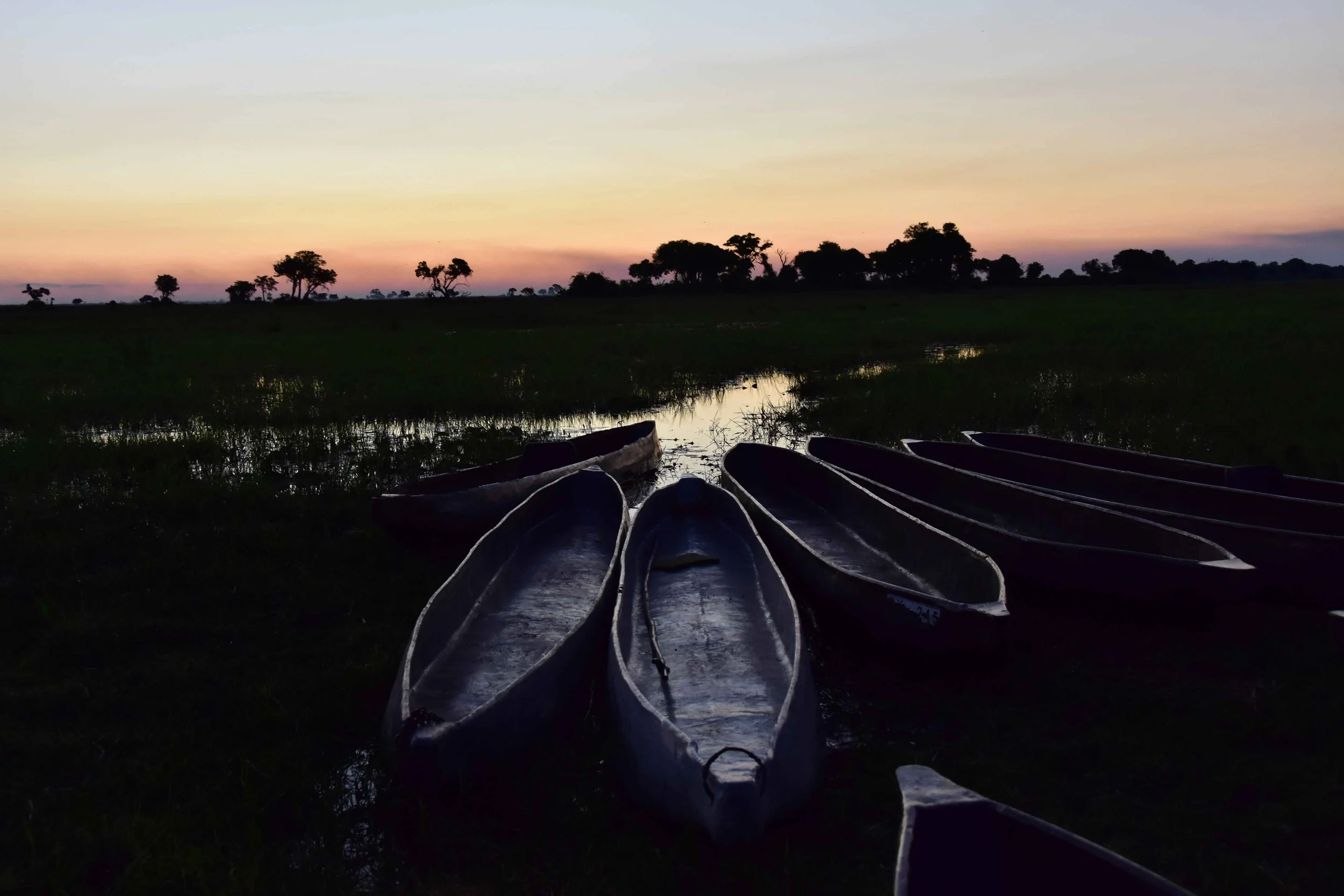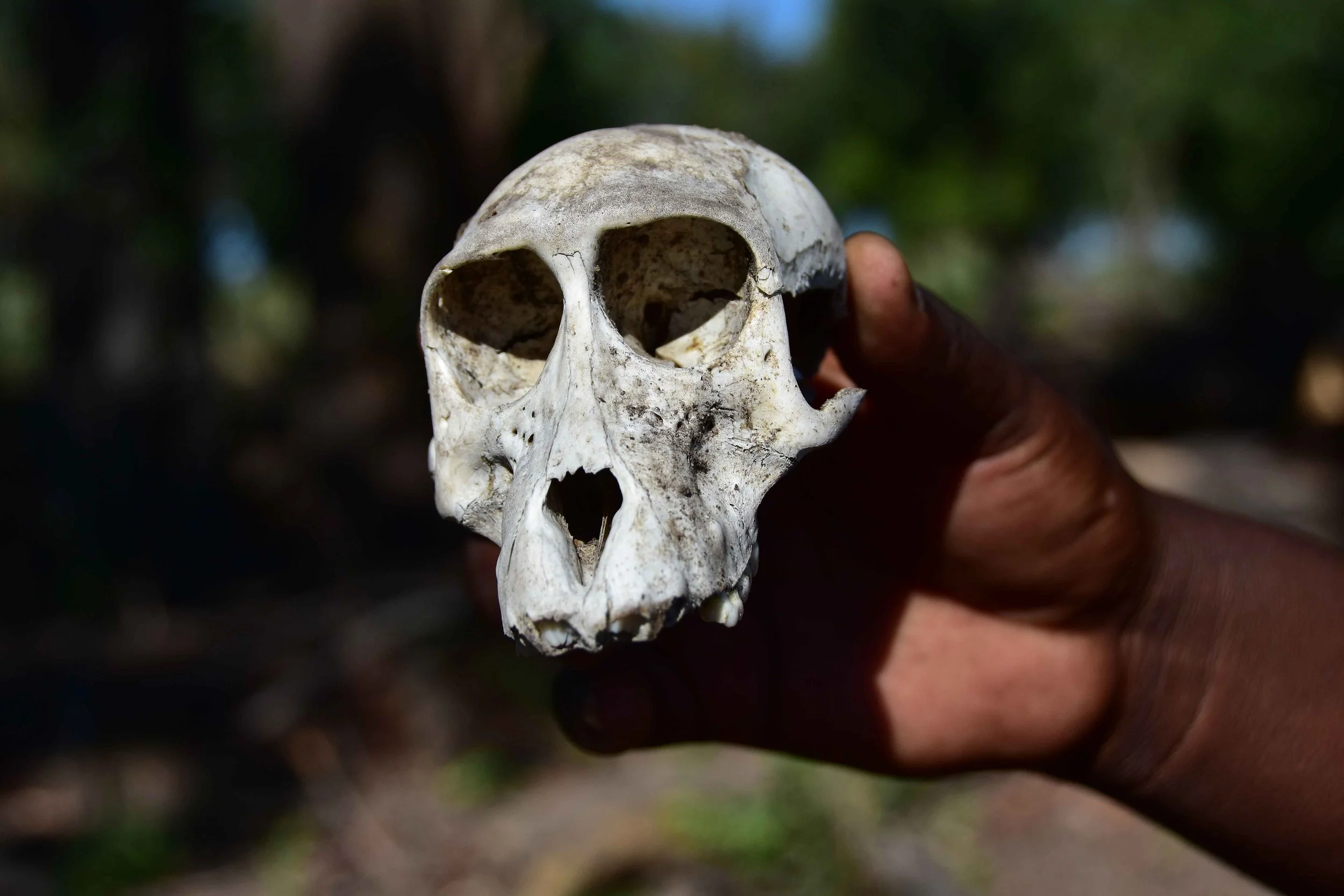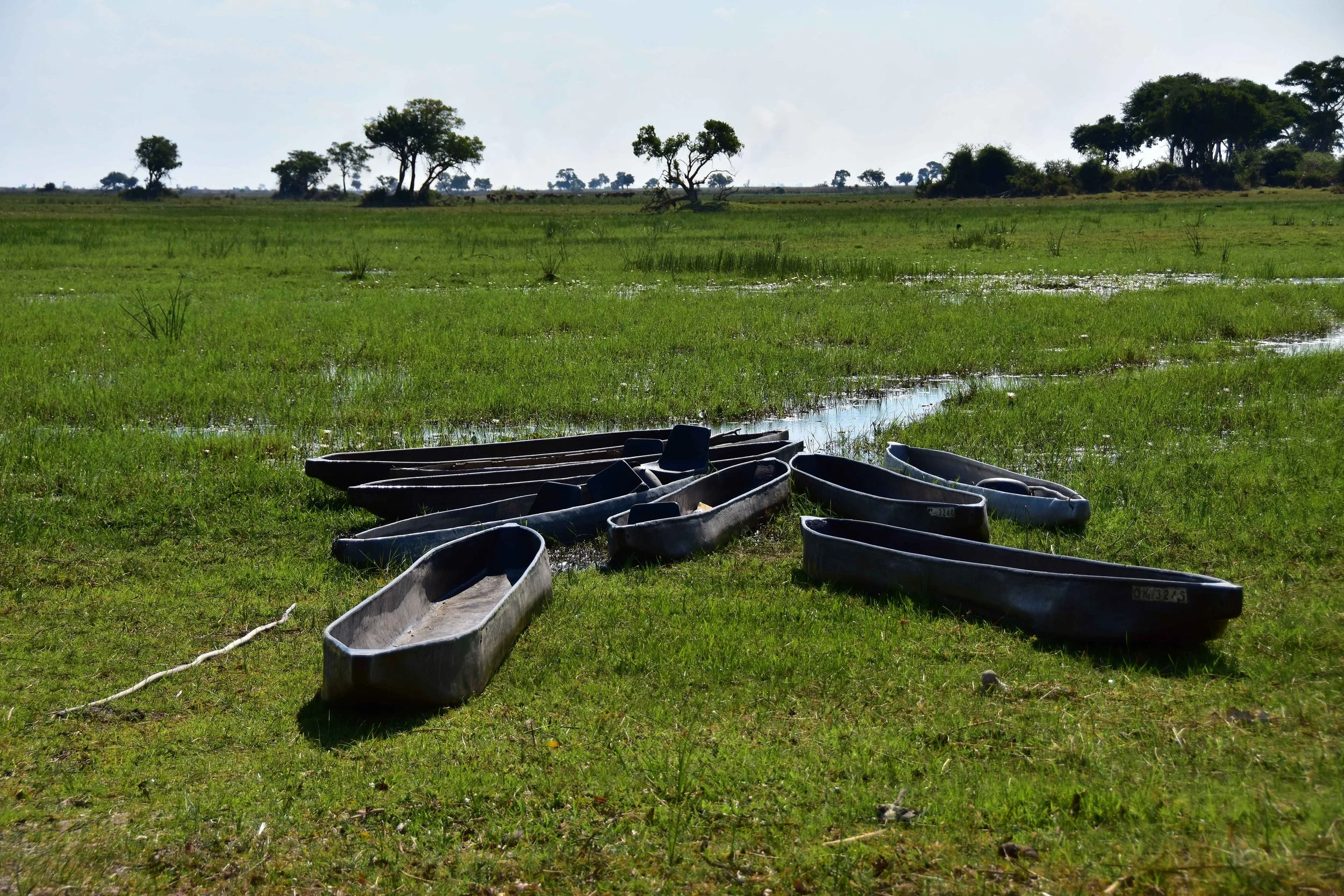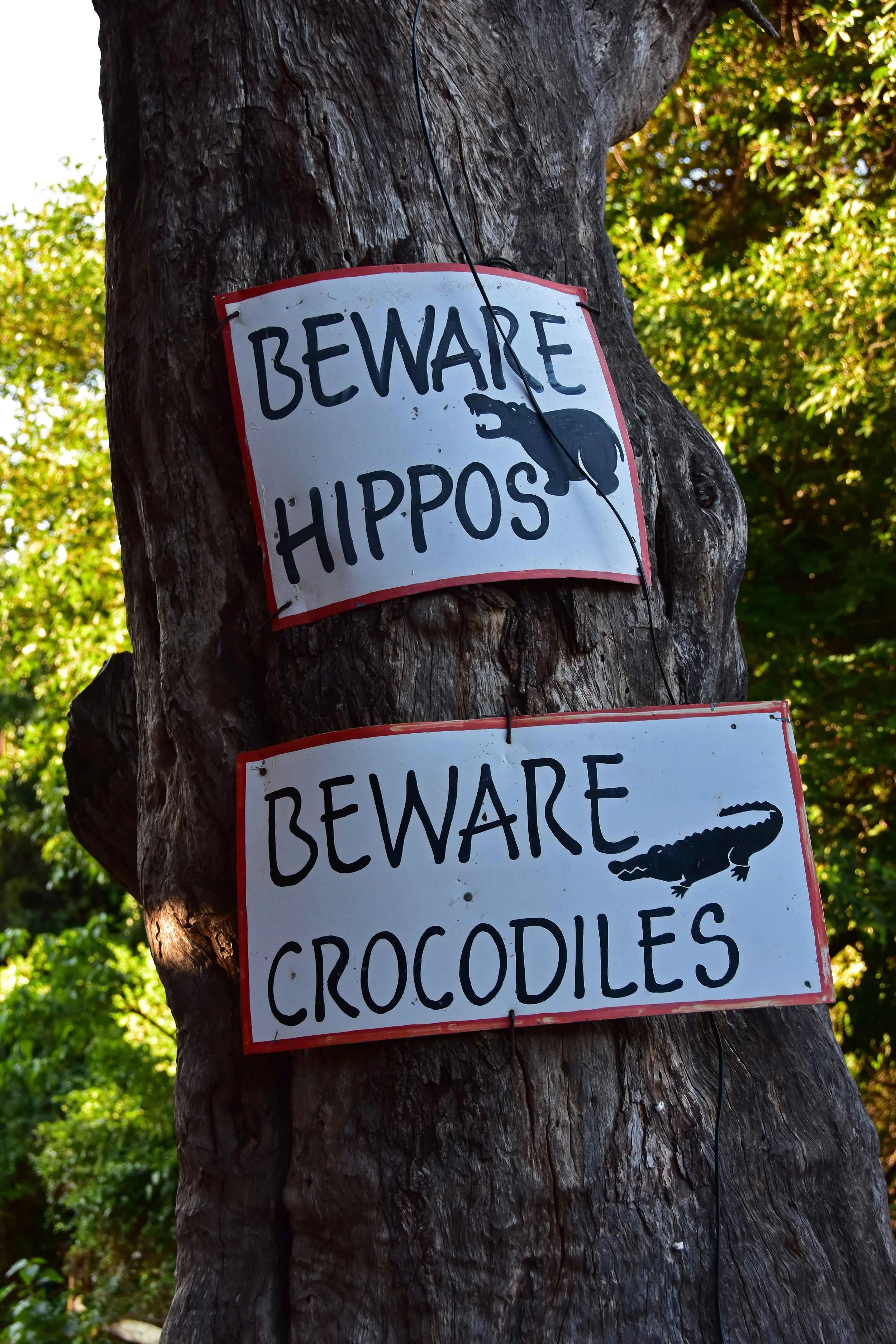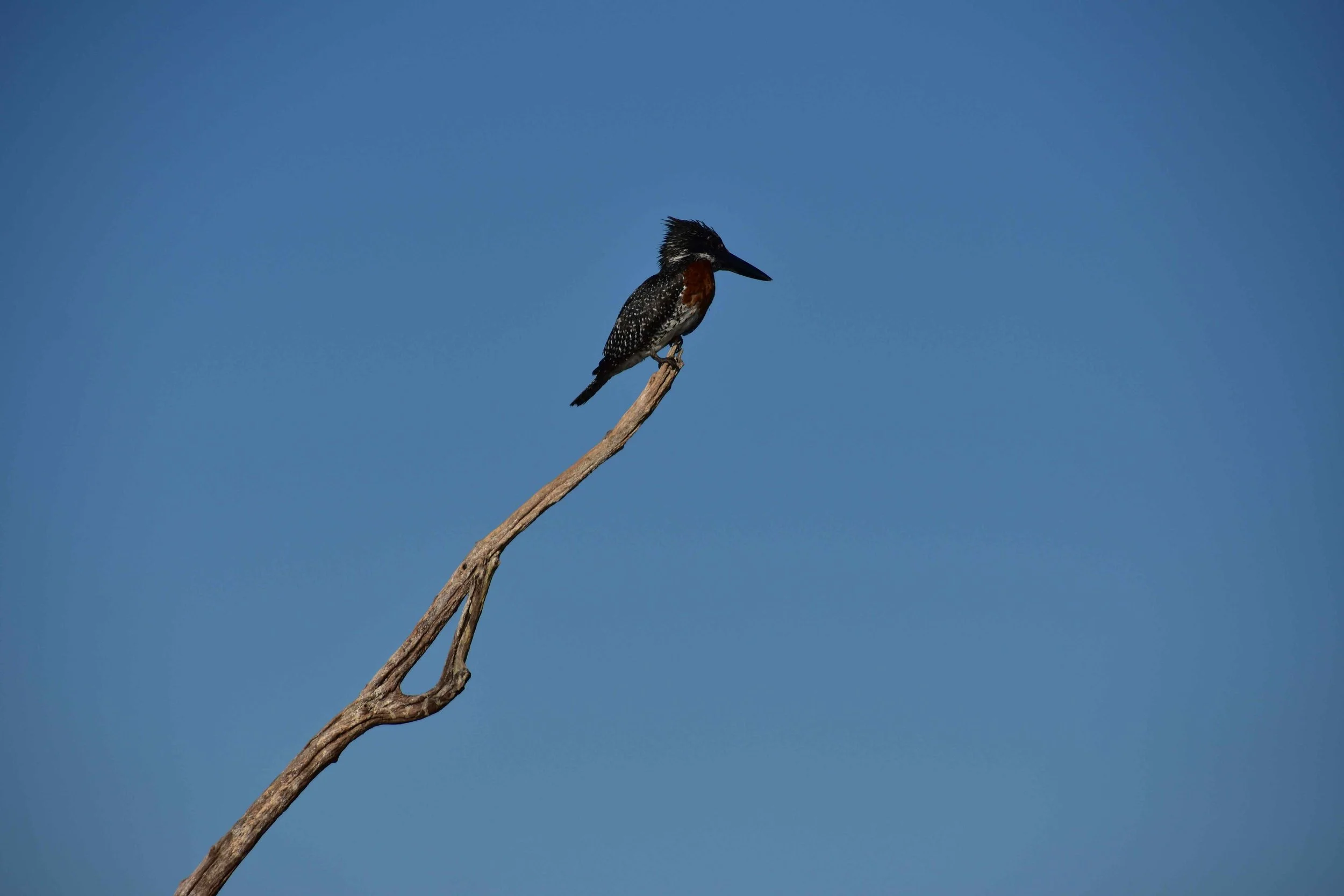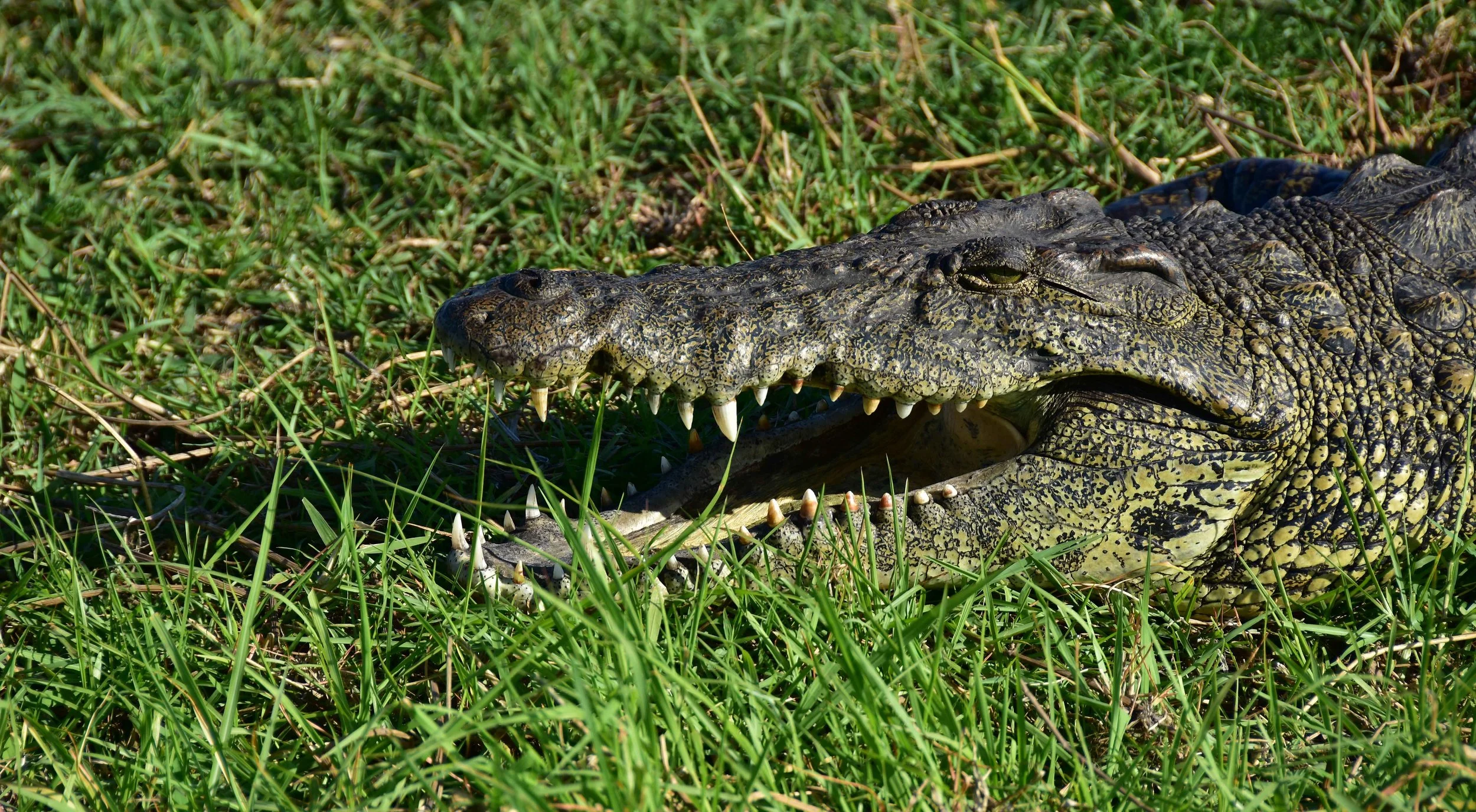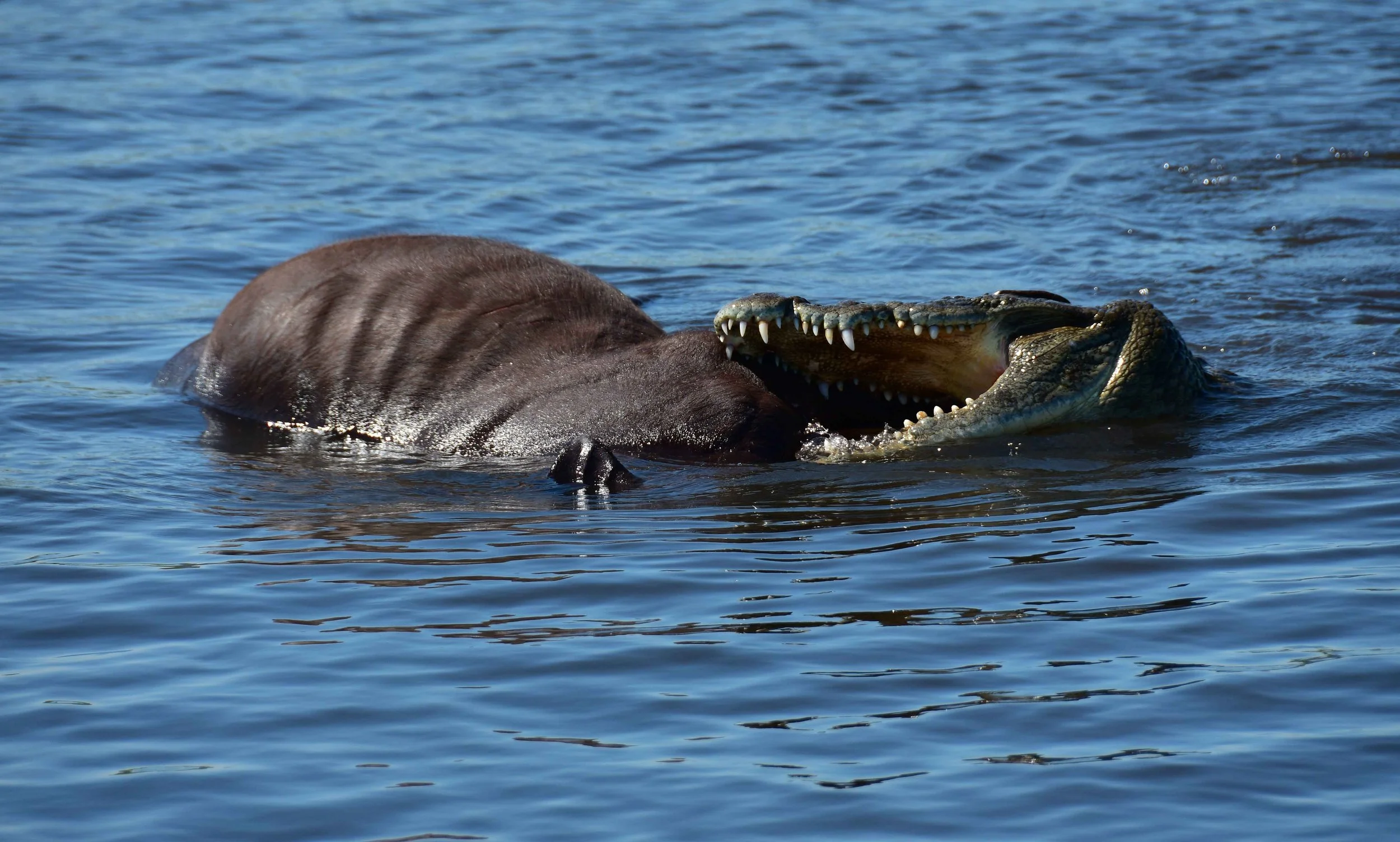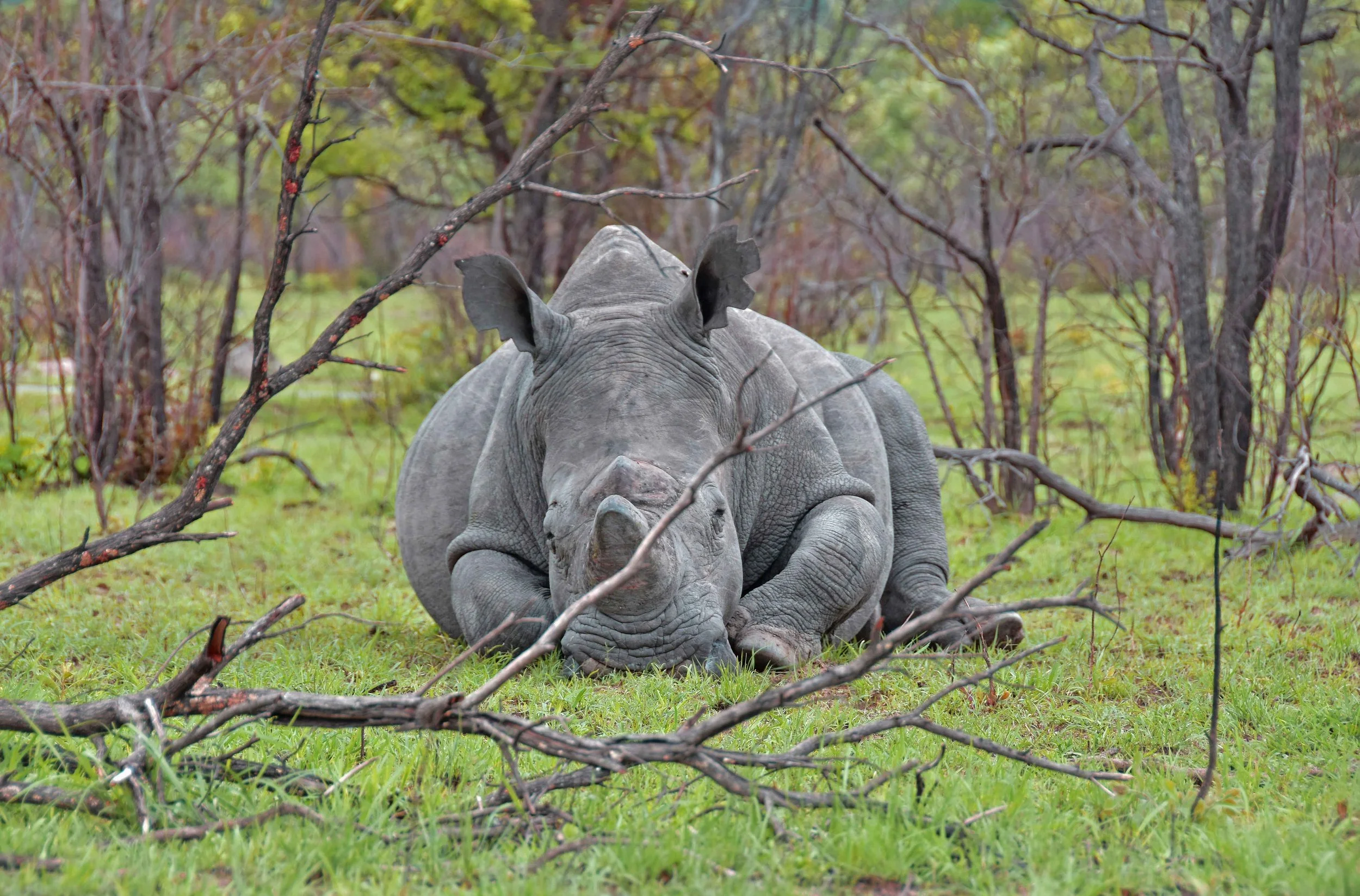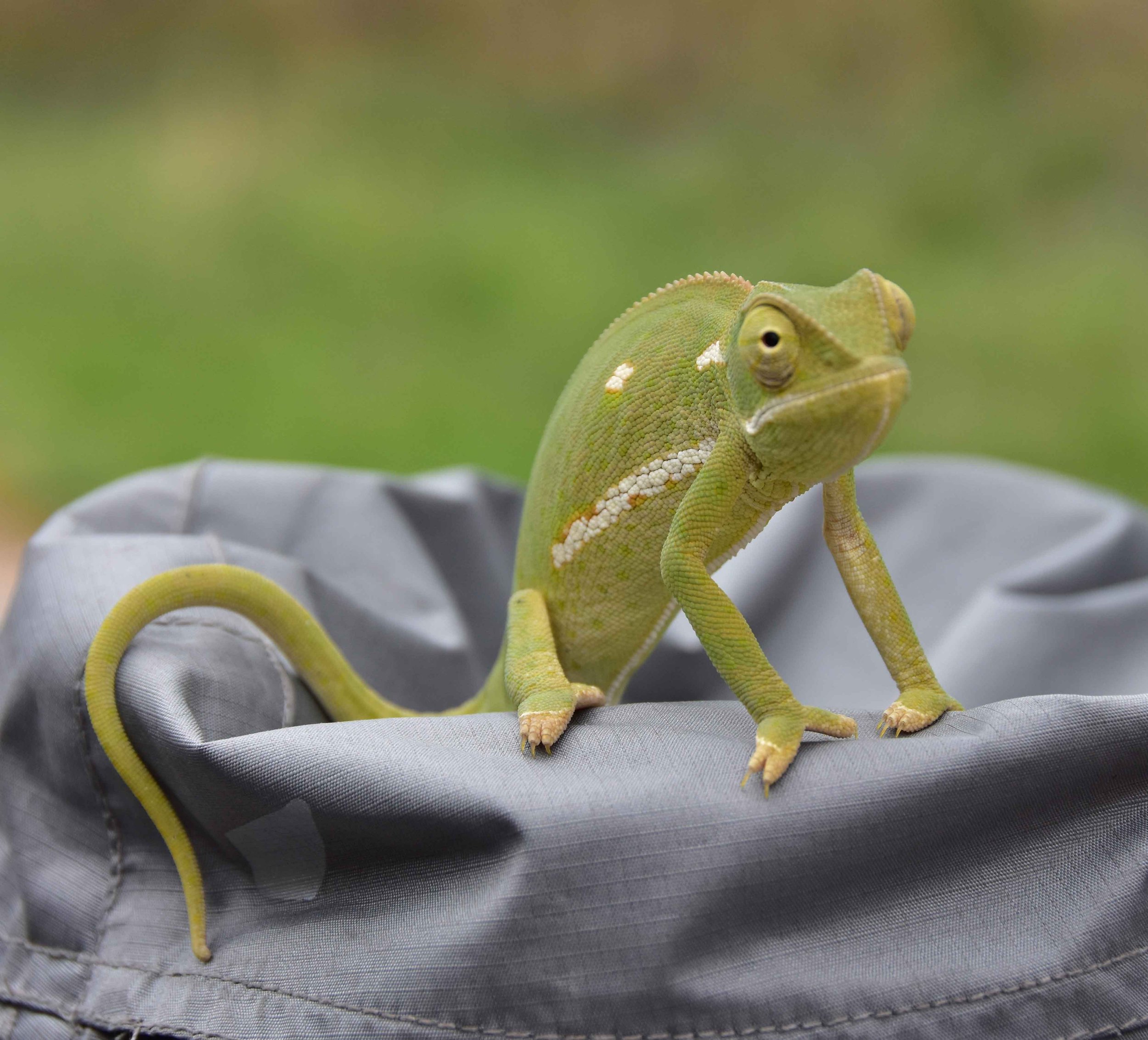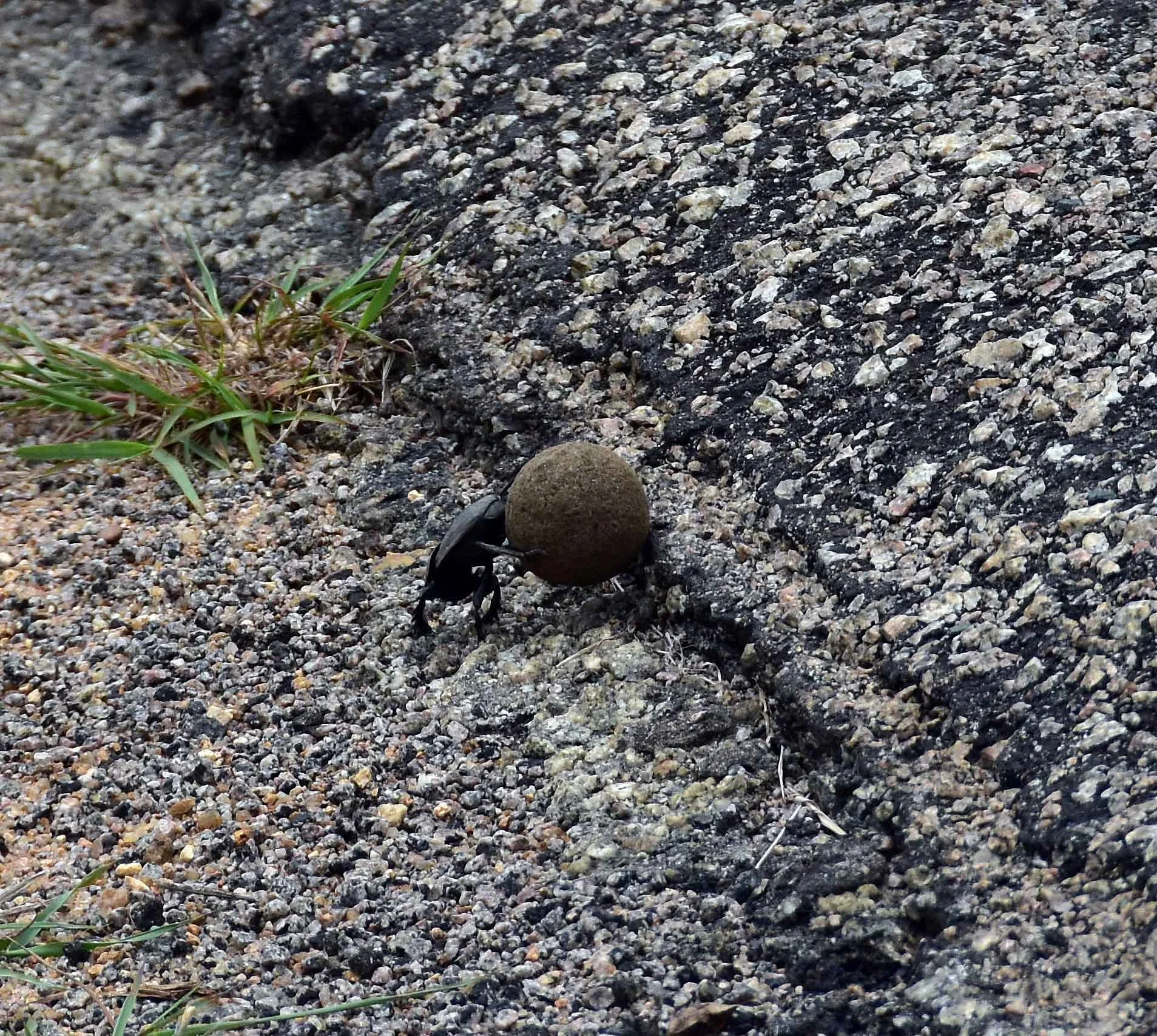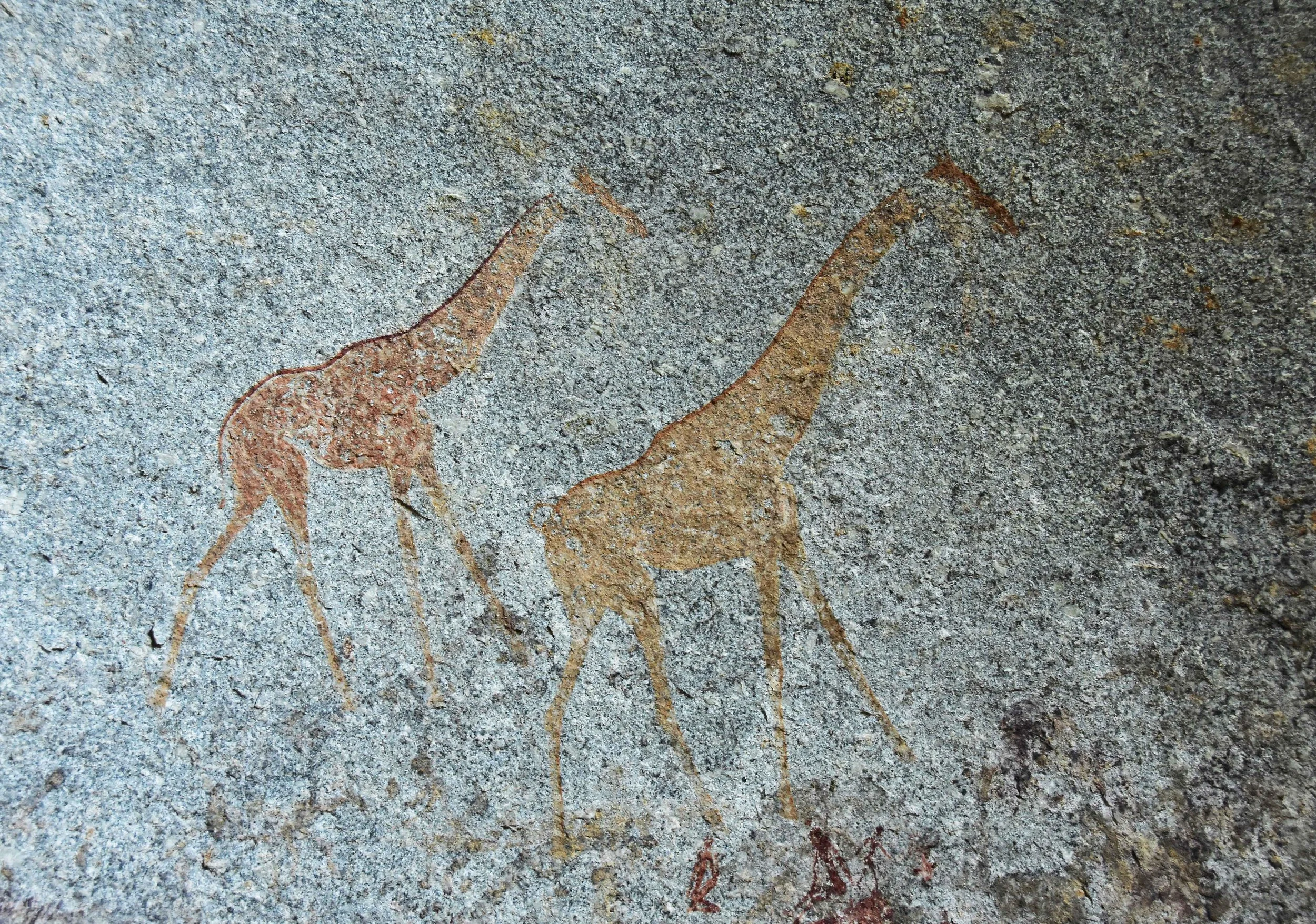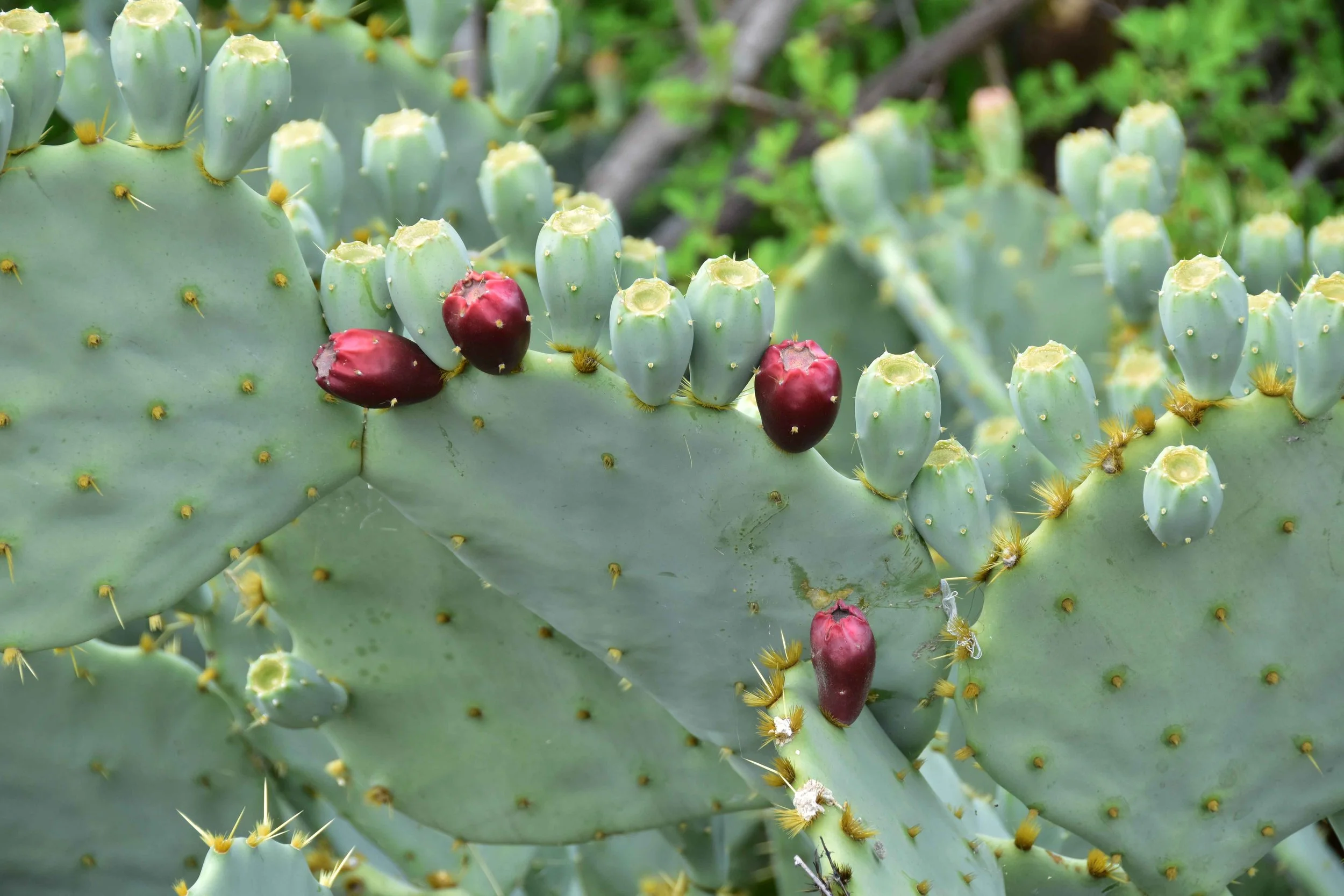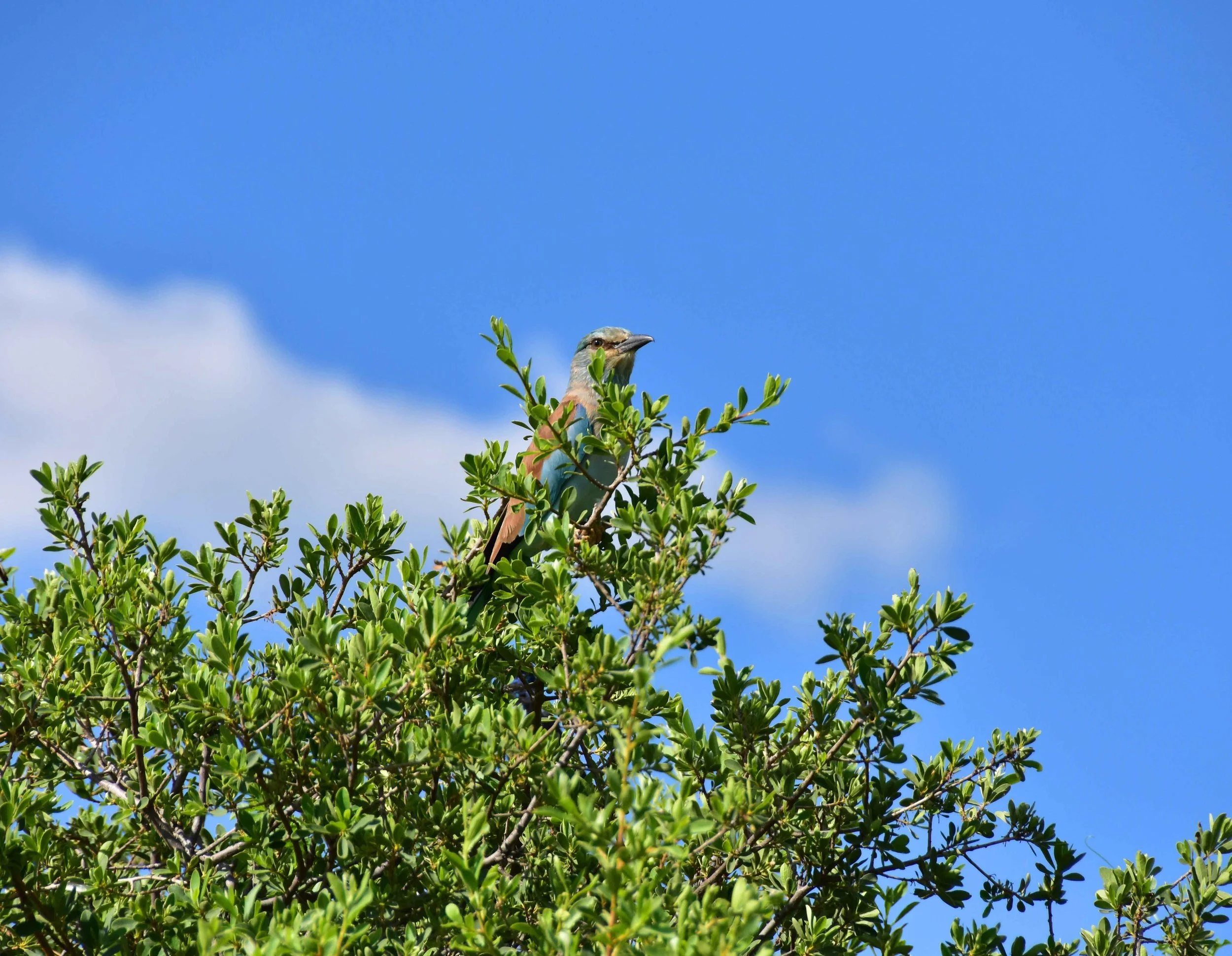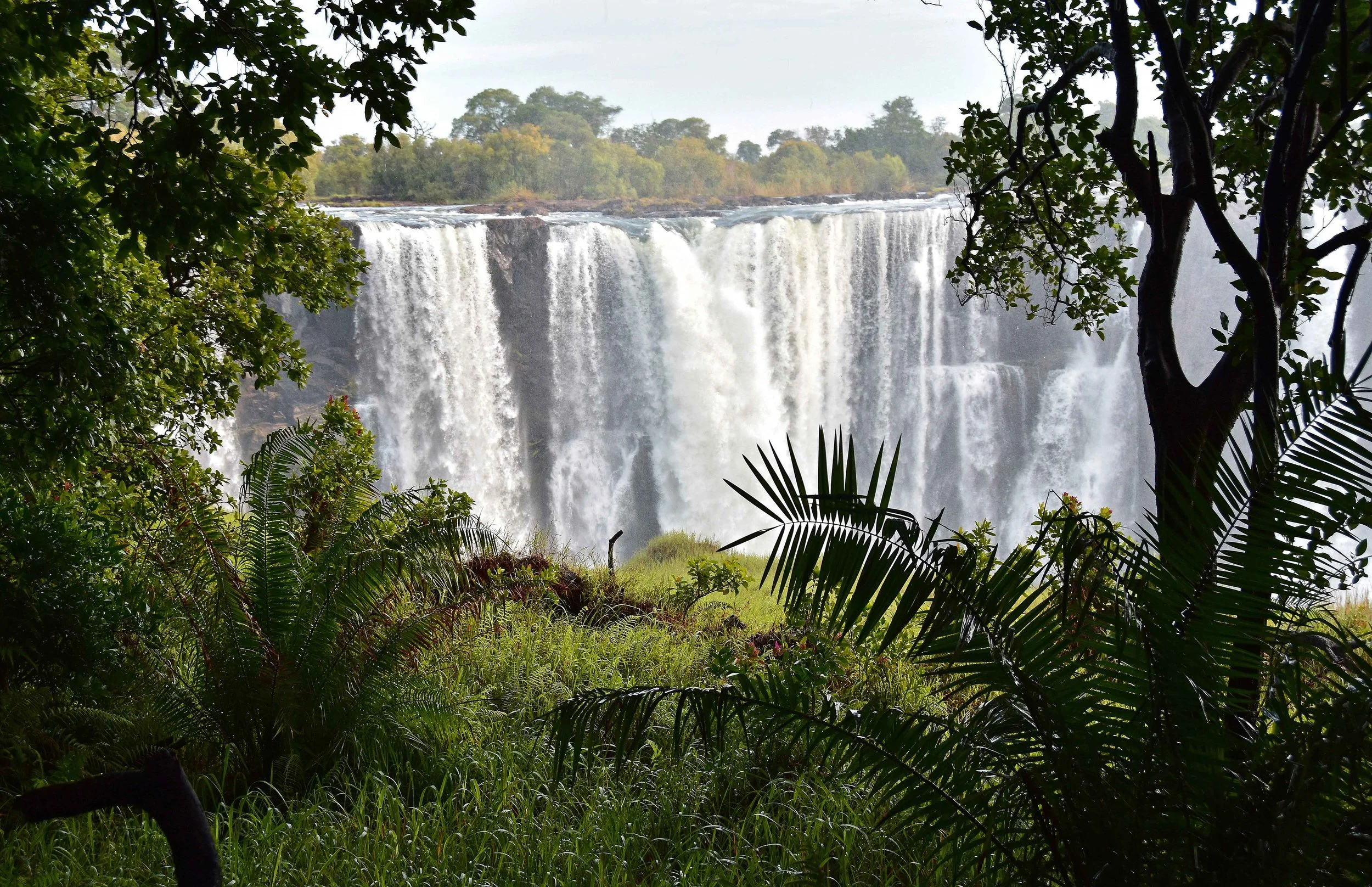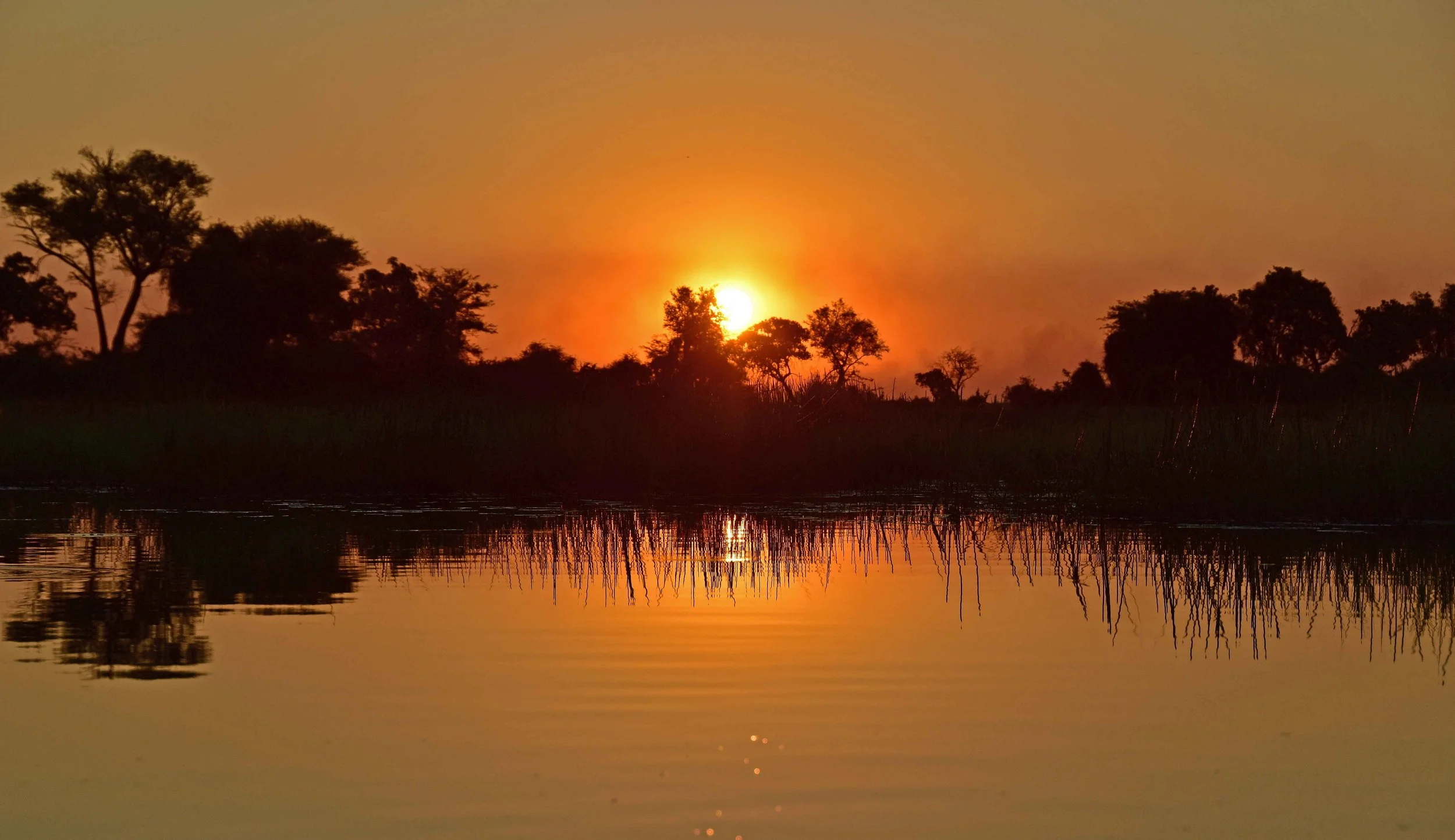South Africa • Namibia • Botswana • Zimbabwe
This was probably the oddest trip I have taken, and a very mixed experience. I went with Dragoman, who specialise in long drives across continents. Their monstrous vehicles look like something Dr Frankenstein created – a truck chassis as a base for driving across the long and sometimes difficult terrain, with a bus upper bolted on to hold passengers. This particular route was from Cape Town all the way to Cairo, with getting on/off points along the way. My itinerary was from the Cape to the Victoria Falls in Zimbabwe, driving through western South Africa, Namibia and Botswana.
The basic cost is relatively cheap but that meant camping pretty much every night for a month. Everyone is expected to contribute to shopping, cooking, cleaning and packing up. We paid into a kitty for food and petrol. Normally they expect about 20 travellers, but ours consisted of seven people only: three young Germans, four English, plus an English guide and two local drivers. I was surprised the trip was running with so few of us.
Despite the low turnout, it was a non-stop saga of emotions: affairs, constant bickering, and spoilt, entitled, ugly first world behaviour towards the locals. Our guide announced on the first day that this was the last time he was doing this trip as he was ‘fed up of it’ and we had to suffer the consequences of his negativity. He had clearly checked out, rolling his eyes about everything, being unhelpful. He was even sleeping with one of the group, which we all knew despite them sneaking around like teenagers. I couldn’t quite believe I was stuck with these people and I found myself wishing that there had been a few more on the trip to dilute the effect. None of this is Dragoman’s fault, I like the idea of a very basic trip, but I would be reluctant to travel with them again.
SOUTH AFRICA
Enough of the negatives, I saw a lot of very wonderful things in a month: vineyards, deserts, big game, tribes, ocean and river, and the mother of all waterfalls. To see so much variety inevitably meant long days driving and sometimes that’s all we did for a couple of days. But when we did stop to see something it was usually spectacular.
I started in Cape Town for a couple of days ahead of joining the group. I wasn’t here long but I didn’t warm to the city. I found it hard to find its heart not helped by the awkward layout around Table Mountain. I spent an afternoon at the aquarium but struggle to remember much about it. The highlight was getting out of the city to the Cape of Good Hope. It’s not quite the point where the western Agulhas and the eastern Benguela currents slap into each other, but close enough to make the coastline dramatic and beautiful.
We drove back via Boulders Beach to see the African penguins. This may be the only time I will ever see penguins in the wild and they didn’t disappoint.
The next day I met the group on the other side of Table Mountain and we set off north. Our first night was in a vineyard in the Cederberg mountains. I am not a wine expert, and I usually find it all a bit of a bore, but I loved the wines we drank here, and I have sought them out ever since. We swam in a sweet little pool, enjoyed a braai, and drank lots of wine watching the sun set before pitching our tents in their backyard for the first night of many under canvas.
My tent was called ‘zebra’ and I had a comfortable night. The next morning we realised how careful we would need to be packing the tents up as one of them had a large scorpion underneath.
NAMIBIA
We stopped at an old copper mining town ‘Springbok’, and you could still see traces of minerals in the rock. I changed some money which was much harder than it should have been in a border town, and we bought some food and then crossed into Namibia. At the crossing, some intimidating South African police officers got on our truck and warned us about carrying anything illegal. One of them was leaning on the onboard chest freezer that contained a lot of contraband meat we were taking with us. Luckily he didn’t ask to look inside. We arrived at the Felix Unite camping site quite late but in time to see the last of the sun over the Orange River.
The next day I spent the morning reading and swimming and then we drove to the lovely Ai-Ais hot springs. Some of the pools were extremely hot but the main pool was the perfect temperature and empty so I had my second swim of the day. Normally this place is full of tourists but we were travelling off-season and it should have been raining.
The area is dominated by the stunning Fish River Canyon, one of the biggest in the world although few people, myself included prior to this trip, have heard of it. The view above would be even more spectacular when the river was flowing at full force.
The quiver tree, so called because its hollowed-out trunk was used by the San people to hold arrows.
Pale-winged starling. One of the high points of this trip was seeing so many birds. I had brought a small book on birds of Southern Africa with me, and I ticked off many of them while I was there.
The first wild animal I saw was one of my top ten favourite animals – the mad-looking giraffe. Really, it shouldn’t have been wandering in this dry terrain, but the late rains were forcing animals to move far and wide in search of water.
I saw lots of different sorts of antelope in Africa. These are oryx which, we were told, ‘never run’, but started running as soon as our juggernaut pulled over to say ‘hello’. We also saw kudu and springbok along this road.
The drive to Sesriem campsite and the Namib-Naukluft Park was very long, but the scenery was spectacular, Namibia is a geological wonder with so many beautiful, colourful, ancient rock formations. We passed what is known as the Giants Playground, so called because of a legend that giants moved these huge boulders, and stacked some like Jenga blocks. Apparently they came out of the ground about 180 millions years ago. This is the place to come for staggering, deep-time numbers.
Equally wondrous are the many termite mounds that you see along the edge of the road that look like chimneys of something living underground; and the nests of the sociable weaver birds who are one of the few birds that build community nests. There was a spectacular example of this at the campsite.
We got up very early to get to Sossusvlei and climb the famous Dune 45. The red sand is made up of dust that has blown here from the Kalahari desert and is about five million years old. Climbing a sand dune looks easy, and I imagined I could just run up, but every footstep sinks into the sand and it took a lot of energy to get to the top. I was glad we had got here early as it looked stunning in the sunrise with one side shaded.
Our exertion was rewarded when we got back down with bacon sandwiches. This pied crow flew down and stole one of them out of someone’s hands – fortunately not mine.
Nothing could prepare me for the weirdness that is Deadvlei. The word ‘vlei’ means marsh and the dampness had allowed these camel thorn trees to flourish a few hundred years ago. Around the 14th century the climate changed and the vlei became dessicated causing the trees to die, but the heat was so intense that the skeletons survived and created this very strange environment. It looked like a stage set: the trees are almost like cardboard cut-outs set against the white salt pan ground, and surrounded by the colourful dunes. This is definitely one of the places on this trip that made up for all the long days of driving.
Afterwards we drove to our campsite via Solitaire where, bizarrely, we found a bakery that had been opened by a Scot called Moose McGregor, and was famous for its apple pies. Very tasty but not what I expected to be eating in the desert.
The drive to the Bosmans Farm Camp was the hottest yet. When we got there I noticed a tempting swimming pool and I wondered why, in this insane heat, it was completely empty. I got in anyway and discovered why: the water was filthy with lots of things, some of them alive, floating around. The woman from the bar came out and asked if I was enjoying my swim. Yes, I said, but casually mentioned it was a bit dirty. Apparently they don’t use any chemical cleaners ‘because of the leopards who come down at night and use it as a watering hole’. I was basically swimming in leopard spit. Luckily the site had fantastic showers.
After the drama of the vleis and the sand dunes, we went to the calm Walvis Bay to watch the flamingos, lesser and greater, and then to Swakopmund to have a break for a few days. The whole group was supposed to share a dorm here, but I spent a bit of money and upgraded to a single room. It was so nice to be on my own.
It feels like quite a small town but it is the fourth largest urban area in Namibia. I loved that it’s where the Namib Desert hits the Atlantic Ocean and it would have been wonderful, but unaffordable, to do a scenic flight along this coast. There is a lot of other things to do around here like sand surfing and quad biking but they’re not really my thing. so I spent the time reading, doing my washing, and getting supplies. We were delayed leaving town by two of our small party who had forgotten to get their required yellow fever jabs for Botswana. So our time was limited along the coast which was a shame as it’s the Skeleton Coast famous for its shipwrecks.
We did get to the Cape Cross seal sanctuary. I don’t have much affinity for seals on land. I have always felt they look curiously unevolved as they flop about aggressively, whereas they are incredibly agile in the water. But it was interesting to see their community up close and personal, although there were lots of dead pups around, mostly killed by rival adults, and the smell was quite intense.
More mind-blowing, geological statistics: the rock formations at Spitzkoppe (‘pointed dome’ in German) are more than 120 million years old. Spitzkoppe is a special place for many reasons and was one of my favourites of the whole trip. As well as the rock formations, there is a lot of San People rock art, thought to be 2000-4000 years old.
One of the locals took us on a walk to see it. It’s thought that the bushmen left messages for others, or they may have had spiritual meaning, but unlikely to be just decorative. There were pictures of rhinos, lions and, on one wall, we could see an octopus. We were miles from the sea there, so that shows how far and wide they wandered. I was also fascinated to learn that they used to empty ostrich eggs, fill them with water, and bury them for future use.
I didn’t see much wildlife in this very dry place not helped by very late rains. But I did find this neat little nest – possibly a weaver bird?
Later, I turned my back on the bickering group and pitched my tent facing this view. I would never have got this pitch in the high season. I enjoyed a peaceful evening contemplating the ages of these rocks and feeling very insignificant (in a good way).
We spent a couple of days camping in Etosha National Park. What a beautiful place it is and vast – 22,270km². It was a chance to see so many of the big animals in one place.
There are several watering holes in Etosha, all looking a bit dried out as they wait for the rains. Lots of animals gather around them and it all seems very civilised as long as the lions don’t turn up.
Near the Okaukuejo campsite where we were staying, there was a floodlit watering hole where we watched black rhinos and elephants come and drink. The rhinos are endangered, and it shocked me to learn that poaching even takes place within the park itself despite being one of the most important custodians of the species.
During the night I could hear something right next to my tent making very lion-like noises. I asked one of the rangers the next morning what this might have been. ‘’That was actual lions’ he said, ‘You pitched your tent right by the fence, they could probably smell you’.
We spent some time watching the lions including this mother and her cubs. She was obviously wary even though we really weren’t that close. One male lion did come by our truck and roar his disapproval.
Etosha is located on a huge salt pan and its name means ‘great white place’. Apparently, when it’s at its whitest, you can see it from space. Above Blue Wildebeest not looking very blue.
On our second evening we were heading back to the campsite and we saw a few jeeps parked ahead. They were not happy about our monster truck approaching and we found out why – a juvenile leopard had been spotted in the scrub. We parked a little way off and sat quietly and luckily he passed us before disappearing. They are usually hard to spot – their coats blend perfectly with the scrubby background. They also spend a lot of time quietly sitting in trees.
The Big Five Game are the animals that were traditionally the hardest to hunt on foot. Thankfully the name is now used more by tourists to refer to the five big animals to spot in Africa. They are rhino, elephant, lion, leopard and African buffalo. When we left Etosha, we had seen four of them.
We drove further to northern Namibia and stayed at Roy’s Farm. A lovely campsite and a touch of luxury – we were camping on grass for the first time since the vineyard! I did lots of washing which I hung on a proper washing line and it dried really quickly. I drank a couple of cocktails and lounged around in the pool. Later on, we went to their sweet little watering hole and saw tiny dik-dik.
We visited a San settlement, specifically the Jul’hoansi. These people were traditionally nomads, traversing vast areas, but were dispossessed of their ancestral land during the apartheid era, and struggled during the AIDS crisis. Now, they have very few rights and live in comparatively cramped western-style settlements. Many of them live in extreme poverty with alcoholism becoming a big problem.
They dress down into traditional clothing and do demonstrations of crafts and bushcraft for tourists. Although it was interesting, it was a display that was understandably half-hearted. Tourism seems an obvious source of income for these people, but it needs to be done in a way that uses their innate bush skills in a practical, rather than performative, way. It was disappointing to learn they had been driven way from Etosha NP which would have given them a chance to do this (although I believe they since have been given land there in 2023).
Our last night in Namibia was the Rainbow Lodge on the banks of the Okavango river, close to the border with Botswana. We arrived late, and left early so didn’t make the most of its beautiful setting.
BOTSWANA
The crossing into Botswana was relatively easy although once again we had to hide meat we were carrying. We took a speedboat to get to the Okavango Delta itself. Along the way we saw crocodiles, fish eagles and hippos. It was disconcerting to see so much fire along the banks where vegetation is being burned off.
We transferred to mokoro boats which traditionally were hollowed out tree trunks, but are now fibreglass. Someone stands at the back end and uses a pole to push the boat forward, very like a punt. I was sitting low down quite close to the water surface which was slightly unnerving. But it was a beautiful experience to push through the water lillies and see more amazing birds.
We could see hippos in the distance yawning and showing us their teeth and I wondered if I would prefer death by hippo or death by crocodile. Probably hippo. It’s not unheard of for hippos to attack mokoros as they mistake them for crocodiles.
Our camp was on what should be an island but the late rains meant the water in the Delta was low and many of these islands were connected to the mainland. This meant that mammals like elephants had access, but also predators like lions. I liked our little camp but I was a bit nervous going to the toilet which was a cubicle tent pitched behind the camp close to which I found a pit of animal bones.
Our sunset mokoro cruise was breathtaking. We were being a bit noisy and our guide hushed us, and told us to listen to the nature and so that’s what we did for a surprisingly long time. The peace eventually broken by the sound of a radio playing loudly as four local workers in two mokoros punted themselves home.
Back at the island we ate spaghetti bolognese for about the fifth night in a row, and took it in turns to make fire.
I slept relatively well until an extremely loud animal noise woke me up. I wondered if it was lions but it was too crude and aggressive. After about an hour there was a loud splash and that was the end of it. In the morning we learned it was a couple of hippos having a fight right by our tents. My knowledge of hippos growing up was from Fantasia where hippos wore tutus and danced. The reality is they are the most dangerous animal in African – to humans anyway.
We were taken on a bush walk which was really interesting – we found a fish skull that had been dropped by a fish eagle from a tree, a baboon skull, elephant foot prints – plus we saw some elephants. And woodland kingfishers calling to each other and a red-throated barbet which was also very beautiful. I found a perfect bright blue feather which I wasn’t allowed to keep (I’m still upset).
We took mokoros to waiting jeeps and drove back to the speed boat passing lots of elephants along the way. Elephants are so abundant here that they are now considered a pest. I sat next to the driver who pointed out a huge elephant skull by the side of the road where two elephants had fought and one of them had knocked down the electricity lines to the local village.
Our time on the Delta ended with a night on a lovely old-fashioned house boat where I had what felt like a luxury cabin – all old wood, brass fittings and white sheets. I managed to find a quiet part of the boat where I read and sipped a couple of gin and tonics.
Although a very enjoyable trip so far for wildlife occasional parts of this tour had been lazily organised and a long drive to Makgadikgadi Pans to see meerkats was the worst. As beautiful as salt flats are, there was not a sign of any life at all. Our guide cheerfully told us that of course there wouldn’t be as it was midday. So the following day two of us paid for a guide to take us back there very early in the morning. We didn’t see any meerkats this time either despite sitting quietly for a couple of hours, but I felt like we had given it a better chance. On the way back we stopped to marvel at a giant baobab tree and its elephantine-footed trunk.
Our last stop in Botswana was the Chobe National Park, the country’s third largest national park. We stayed at another nice campsite by the river, with another great pool which was fortunate as the temperature was in the mid forties. We pitched by the river itself despite the signs.
It wasn’t hippos or crocodiles that I encountered but a snake early the next morning in the toilet block. I could see its tail sticking under the door of my cubicle which my sleepy eyes hadn’t noticed when I went in. I had no idea how big or dangerous it was, or what it would do when I opened the door. So my choice was to chance it, or stay there forever. I tentatively opened the door at which point it snaked away – a Puff Adder, one of the most venemous in Africa.
We spent Christmas Eve on a boat on the Chobe river getting really close to hippos, crocs and lots of birds. Also we also saw buffalo which means we had ticked off all of the Big Five.
The park is famous for its lions but my time here was all about the elephants.
We came across a very large group of elephants cooling off in the water. One by one, they gradually got out of the river apart from this one who wanted to stay there longer. Some of us just love being in the water!
Crocodiles are probably the animals that made me the most nervous. There were quite a few along this river, just sitting there, static, staring, waiting. Absolutely terrifying. We saw this one below dragging a kill, an antelope or a buffalo, through the water.
ZIMBABWE
Our transit into Zimbabwe was remarkably straightforward considering the long queues at the border point and the apparent chaos. Our driver, Denford, is Zimbabwean and we noticed him shaking hands with lots of official-looking people so perhaps that helped.
Zimbabwe, like Sudan, is another country that is perpetually portrayed negatively in Western media. I had anticipated some flat dust bowl but our first drive in was through lush countryside and mountains with a dramatic thunderstorm in front of us. The only indication of anything out of the ordinary was an extremely long queue of cars parked at the side of the road for a petrol station some miles ahead. Our camp was in Bulawayo where I had a small, very basic chalet but it had its own bathroom and this was comparative luxury!
What a relief to discover we weren’t going to be causing chaos in the Zimbabwean national parks with our truck. Instead we were put in the hands (and jeeps) of Ian Harmer, a local conservationist and safari guide, and his co-guide Jordan. He came over in the evening to talk us through what to expect. In the background were the loudest frogs I have ever heard, so much so that he had to raise his voice. The next morning, there was a giant snail sitting by the jeep. Zimbabwe was already feeling very strange and I was already enjoying it.
When we arrived in Matobo, we were due to spend a few hours tracking rhinos so it was a lovely surprise to find them already there waiting for us – including a mother and her calf. We edged quietly towards them and sat at a safe distance which still felt very close. Their eyesight is poor so were unlikely to see us, but they have great smell and, as Jordan put it, were more likely to notice the smell of our sunscreen. The fact that they didn’t run because they could smell us is another indicator of how easy it has become to hunt them.
Is there an animal that better exemplifies how destructive human greed and stupidity can be than the rhino? The horn, which is made of the same substance as human toenails, is a prized luxury in Asian markets and as a fabled aphrodisiac (which it isn’t). Hunted, poached and brought to the point of extinction purely for this bit of tissue, this beautiful animal now depends on those few good souls to protect it. I pity some of the local people who have so very little, but are being bribed by poachers to help track rhinos. Tourism isn’t always the solution to global problems, but in the Zimparks as they’re known, it’s vital to support local economies and to give people employment. I wish more people knew how beautiful Zimbabwe is, and would visit here.
The rhinos were the animal highlight of the whole trip for me, I felt it was a privilege to see them up close. If poaching continues, there’s a chance that future visitors won’t see them at all. But there was plenty of other fauna in Matobo: multi coloured lizards and agamas, chameleons, dung beetles, eagles, elephant shrew, monitor lizards and wildebeest.
Jordan came screeching to a halt at one point and we were amazed that he had spotted a tiny dung beetle pushing its very neat dung ball across the road.
One of the most distinguishing features of Matobo are the Flintstone-style boulders of rocks. Sometimes they create strange formations as they balance on top of each other. Humans have used these rocks since the Stone Age as shelter and they are famous for the rock paintings like the ones we had seen in Spitzkoppe.
We sat and watched the sun set, as fearless little elephant shrews played nearby, at the top of the Rhodes Memorial where Cecil Rhodes and other white imperialists are buried. Unsurprisingly a controversial choice of name as much of the park is considered sacred by indigenous groups. Sacred or not, it was a beautiful end to a special day, spoilt only very slightly by someone with a drone.
There was one last surprise: we were promised a ride on the ‘Matobo roller coaster’ which was a very pronounced steep dip and immediate rise on the road out of the park. Jordan drove extremely fast and we all screamed.
The next day we drove to Hwange National Park (originally called the ‘Wankie’ NP, it’s no surprise it’s changed its name). The park has had a much higher number of poaching incidents like the killing of over 100 elephants by poisoning the water holes with cyanide. It was also home to Cecil, a 13-year old lion, hunted and murdered by a rich American dentist. I remember what an outrage this caused around the world when it happened and the ensuing debate about why people care more about the death of animals than humans. To me, the two are inextricably linked: if you kill animals for pure fun, you have lost your humanity.
We visited the Painted Dogs Conservation Centre first. I have to admit I knew nothing about them when I arrived but I learned they are unique to Africa, and of course endangered. I love the fact that they literally look like someone has splodged them with paint.
In Hwange itself we saw warthog, lions, giraffe, kudu but the most impressive were the many beautiful birds including carmine bee eaters and lilac-breasted and european rollers, hornbills that seal their female mate in a tree during incubation, spoonbills and cranes with fancy crowns.
We drove to a watering hole and were delighted to find that Jordan had a mini gin bar in the back of his jeep. I had two large gin and tonics and watched the sun set but the peace was disturbed when we spotted a large group of birds around something over the other side of the water. We drove round there to find hundreds of raptors circling what we think was a toppled termite mound. I tried to take a photo but, to be honest, I was a bit squiffy by this point and I couldn’t capture the slightly trippy experence of swarming birds overhead. It was one of those times where you just have to put the camera down and enjoy it.
In the evening we drove to a couple of watering holes. At the first we watched the sun set and a group of hippos yawning. Then to a nearby smart hotel to watch elephants that come to their more upmarket watering hole. Once my eyes had adjusted to the dark, I could make out loads and loads of elephants including a baby running after some geese. Just to make the experience really special, a large pack of painted dogs ran across the road on our way back.
Our last nights were spent at a Victoria Falls campsite that was immediately adjacent to a live music festival: the stage and speakers were right by our tents. The noise was insanely loud and I didn’t think I would get any sleep, but bizarrely I zonked out straightaway. The only thing that woke me up briefly was a thunderstorm in the middle of the night. I couldn’t even tell you what sort of music it was.
On Christmas Day, I had a helicopter ride over the Victoria Falls. It’s still very dry so the falls weren’t at full throttle, but very impressive even so. I sat next to Dave, the pilot, who told me that if anything happened to him, I would have to land it.
Later on we had a final meal and a couple of mojitos at the Three Monkeys restaurant with the rest of the group, some of whom were still not speaking to each other.
Boxing Day was spent wandering around the Falls themselves on my own. It wasn’t the tourist season and it was very peaceful. Despite the drought, there was a lot of water vapour and I still managed to get soaking wet. I had to dash to the airport afterwards still slightly damp where I flew back to Jo’burg and then to London.
Writing up this trip, there were so many wonderful things that I saw and experienced. I think the highlights for me were Deadvlei and Spitzkoppe in Namibia, and Matobo and Hwange in Zimbabwe. I didn’t think I was the sort of person who would enjoy game drives, I normally prefer cultural holidays and good food. But I was happily wrong about myself, and was astounded by the huge range of animals that exist in Africa, and the struggles they have trying to survive various challenges like land loss, poaching and drought. I also loved the birdlife and, in a rare moment of bonding with a member of the troublesome group, I shared my little bird book and he shared his binoculars and we ticked off quite a few species.
Despite all the human drama, and my fellow travellers displaying more savagery than any of the wildlife I saw, my memory of the trip is very positive.













